This is a 2003 interview with Nujabes about his debut album, Metaphorical Music. It’s kind of special in that it is one of very few interviews ever given by Nujabes. In fact, according to friends who were speaking about him in a posthumous Japan Times article, this is “the only interview they could remember him ever doing.” That certainly makes this a rare treat.
A special shout-out to members of the r/Nujabes community for pointing me in the direction of this interview. I only wish it was ten times longer! (Interestingly, while the article was first published in 2003 and reprinted online in 2020, both versions had a couple of sentences missing between them. I carefully compared the two to make this translation as complete as possible.)
Happy birthday, Nujabes.
Interview & text: Sound & Recording Magazine (October 2003 Issue) (Japanese text)
Photography: 八島崇 (except ※)
English translation: Henkka
Nujabes links: Website, Twitter
Nujabes is a talented underground hip hop track maker who has been gaining prominence for his work published through the Hydeout Productions label in which he takes his sampling sources and puts them to their best use. On his first solo album, Metaphorical Music, he makes the listener rediscover the appeal of said sampled music by interweaving it with spirited MC’s and jam sessions with live instrumentalists.
We visited Nujabes at his private studio where he made the album to ask him about his track making process.
Nujabes runs the Hydeout Productions label through which he has since 1999 been releasing 12-inch analog singles featuring up-and-coming underground hip hop MC’s, such as Funky DL, Pase Rock (Five Deez), Shing02, and Apani B-fly. This series of self-produced works have received critical acclaim not only in Japan but overseas as well. Nujabes says he first started making sample-based tracks in 1998.
Nujabes: I used to make music back in high school, but I just couldn’t get fully into it and so I stopped. The reason I started making tracks again was because I wanted to hear music which sampled all the old soul and jazz that I liked.
At first it wasn’t so much me trying to make actual songs as it was just seeing what would happen when I took a sample from one record, made a loop out of it, and layered another sample over that one. I got so much pleasure even from just creating those phrase loops—when I made my first one I spent like the whole day just listening to it. (laughs)
Nujabes’ initial production system was a Mark of the Unicorn Performer sequencer combined with an Akai Professional S3000 sampler. He says he used a Roland VS-880 as the recorder and a Roland M-12E as the mixer, but as he became more and more absorbed in track production he gradually expanded his array of equipment.
Nujabes: For my sampler I quickly switched over to an Akai Professional S950, and later for capacity and system compatibility reasons I started using an E-MU E5000 Ultra. I currently use an Akai Professional MPC2000XL for rhythm sampling—the nuances in the tone sound better to me on that. But I still use the E5000 Ultra for overdubbing samples. Also, about a year after I started making tracks again, I switched over to the Steinberg Cubase VST for my sequencer.
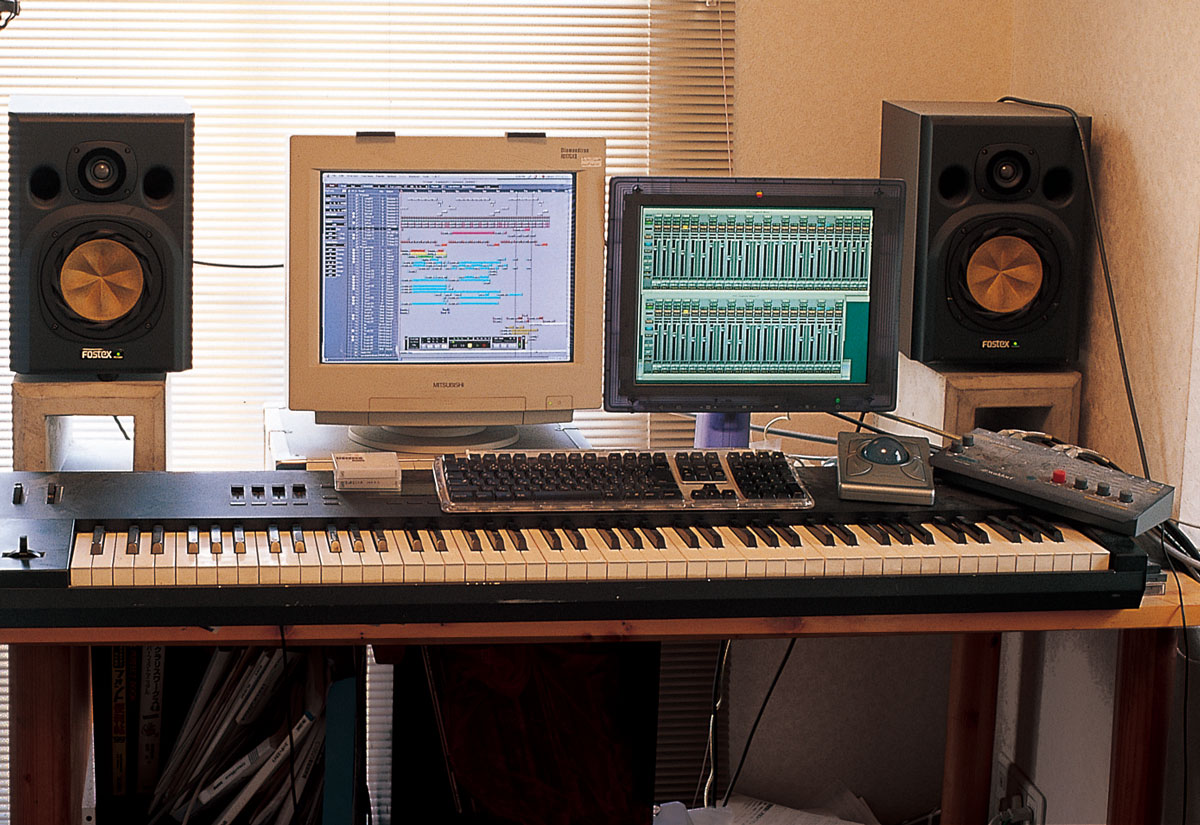
Nujabes’ main workspace. The monitors are Fostex NF-1A’s, and seen running on the screen is Steinberg Cubase VST (through an Apple PowerMac G4/500MHz). Set up on top of his master keyboard, the Roland A-80, is a Waldorf 4Pole.
This is the kind of system Nujabes uses to work on his tracks. However, with the samples captured by his sampler, he says he doesn’t record them on the Cubase VST—rather, they are recorded down on a master DAT.
Nujabes: The Cubase VST is what I use to integrate the raps and MIDI sequences. The sound is totally different depending on if it’s coming directly from the sampler versus something captured on the computer. So for the drum sounds and stuff I don’t use any plug-ins—I create the sound with the MPC2000XL’s internals and an SPL Transient Designer Model 9946, and then the EQ and compressor on a Yamaha 03D. When it comes to drum sounds I’m especially finicky about regulating the durations, and that’s where the Transient Designer comes into play a lot.
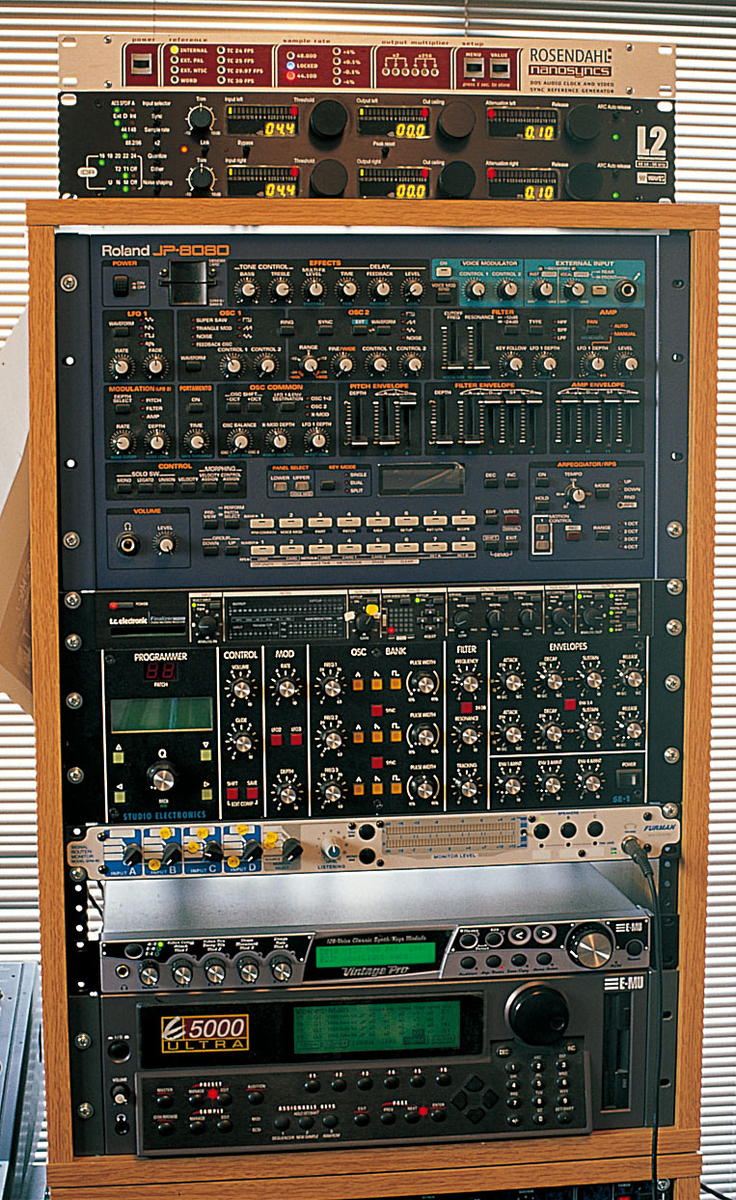
To the right of the main workspace is a rack for outboards and sound sources. Sitting on top of the rack are a Rosendahl Nanosyncs and a Waves L2 Ultramaximizer, and mounted inside the rack are, from the top: Roland JP-8080, TC Electronic Finalizer Express, Studio Electronics SE‐1, Furman SRM-80, E-MU Vintage Pro, and E5000 Ultra. The JP-8080 and SE‐1 are mostly used for bass.

From the top: SPL Transient Designer Model 9946, Panasonic SV‐4100, Tascam DA‐20MKII x2, DBX 120XP.

Set up under his main mixer, the Yamaha 03D, are TEAC AV-P255, Roland M-12E, JV-2080, Mark of the Unicorn 2408 and MIDI Timepiece, Roland P-330 and D‐110, and Yamaha TG77.
Furthermore, as a track maker who has a great appreciation for his sampling sources, Nujabes takes meticulous care in how he cuts his samples.
Nujabes: When I first learned of the Propellerhead ReCycle!, I was going, “I can’t believe something as useful as this exists.” However, there’s simply a clear as day difference between something that was calculated and split up by software, and something that’s been cut by hand. It’s like the sample loses that taste from the cut; that sharpness. You can tell right away. “They used ReCycle! to cut this.” I think once you’ve gone through that process over and over again, anyone would start to recognize the difference. It’s a huge difference. So if it’s a sample where I feel like I want to retain its nuance, I always make sure to work on it by hand.
As Nujabes describes above, he has a strong affection for sample-based track production. His first solo album, Metaphorical Music—comprising of six tracks featuring MC’s Pase Rock, Cise (Cyne), Shing02, and Substantial, alongside nine instrumental tracks—is striking in the variety of its samples which intersect layer upon layer to create a deep, mystical sound.
Nujabes: Having been doing track making so far, I’ve finally began to see more clearly the coordinates of what exactly it is I want to express with my sound. If I had to put it into words, it’s the things I think in my everyday life; the things I feel… So, as per the album title: “music as a metaphor.” There’s so many different aspects to music, but I feel like track makers often fail to see a lot of it. It’s like they’re conforming to a certain formula, or like, they analyze trends only because that’s the methodology you’re “supposed” to follow, and so they’re unable to detach their music from those commercial aspects of it.
Since I am myself an independent musician, I think it’s important I work with MC’s who share the same perspective and express the things I personally find important.
This “sharing of the same perspective” is something Nujabes maintains even when recording his MC’s. With his first album, as well as with all of the records in his series of releases from the Hydeout Productions label, Nujabes has invited all of the MC’s to record at his own private studio.
Nujabes: I could send the finished tracks overseas and just have them record their raps on top of them over there, but if I did that I wouldn’t be able to give the MC’s any direction on the spot and I wouldn’t have any face-to-face contact with them. That’s why I don’t wish to do that. Sure, it’s expensive and difficult, but that’s how I’ve continued to do it.
I record all of the raps on an AKG Solid Tube and the 03D mic preamp, so there’s still plenty of room for me to improve in terms of sound quality. Although for me the most important thing isn’t sound quality, but rather the process of getting closer to that image of my ideal sound—including with the mixing which I also do myself.
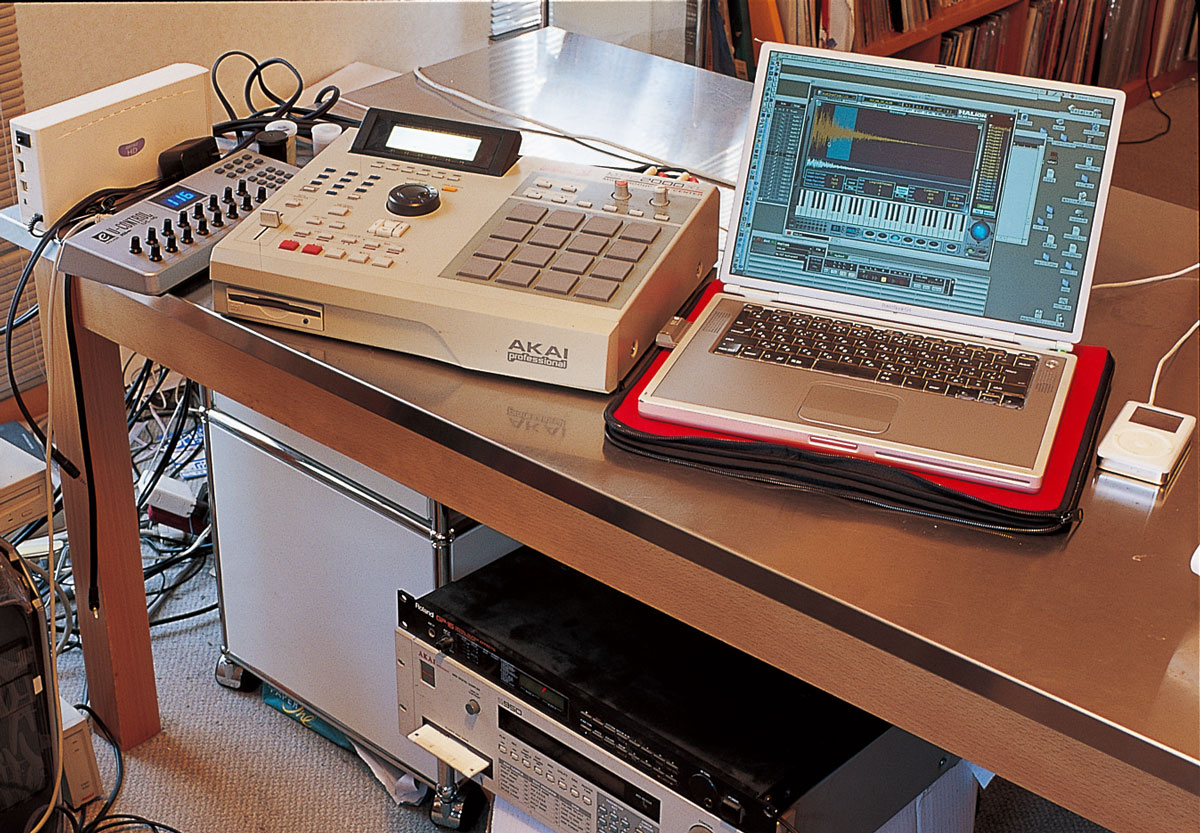
Set up on the desk opposite to his main workspace are an Evolution U-Control UC-16, an Akai Professional MPC2000XL, an Apple PowerBook G4/800MHz, and an iPod. Under the desk are, among other things, a Roland GP-16 and an Akai Professional S950.
One of the things born out of Nujabes’ process of getting closer to his “ideal” is URBAN FOREST, his unit with Tokui Nao.
Nujabes: While my work on Hydeout Productions will continue to be sample-based, the fact is that there aren’t a lot of variables when it comes to programmed music. That’s why I want to bring things like Cycling ’74 Max/MSP to my work, and I’m now researching all that with Nao as URBAN FOREST. Utilizing software like Max/MSP, it increases the possibilities for sample-based music through things like granulation for instance. I want to broaden my options in that way, while also introducing things like live percussion into my track making.
Also, I recently started up Tribe, a record store which I see as an extension of Hydeout Productions. Everything at the store is stuff I went and bought overseas myself, and my hope is for people to come in, listen to old records at their leisure, and hopefully feel inspired by those records to make good tracks themselves. That’s another thing I would like to cherish doing in the future—creating those sorts of encouraging environments.
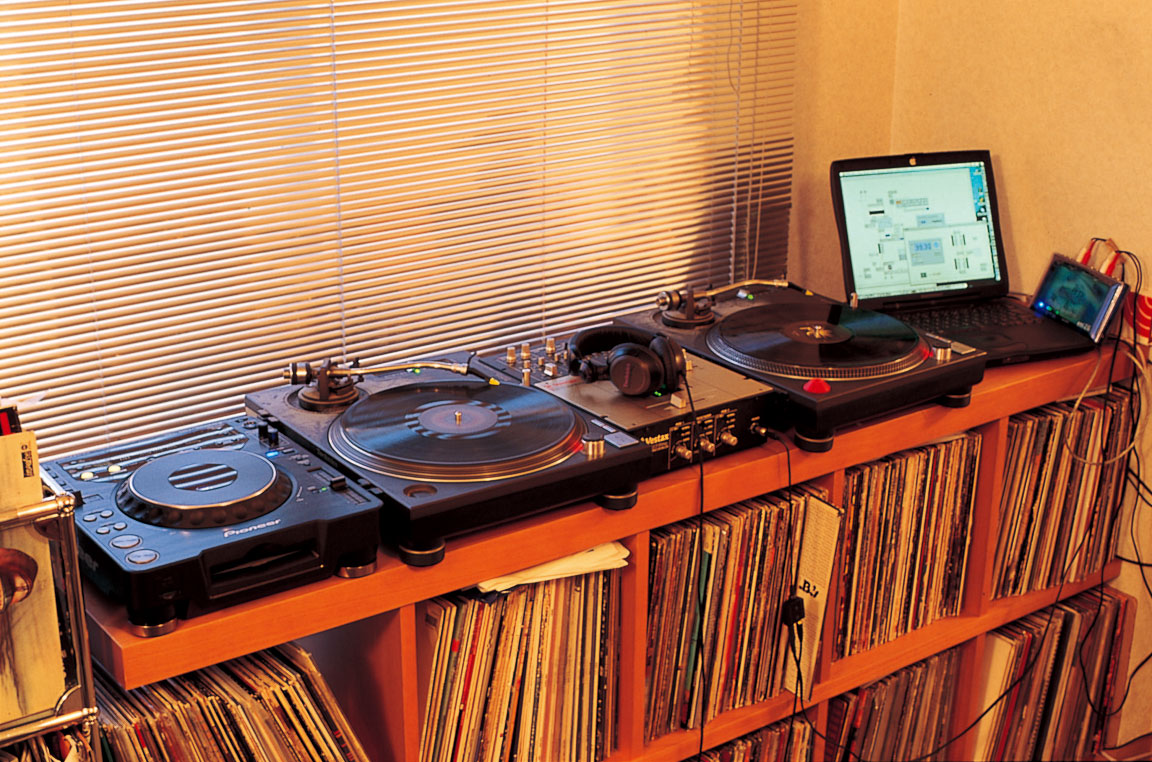
Set up by the window is Nujabes’ DJ set. From the left: Pioneer CDJ-1000MK2, Technics SL-1200MK3 (using an Ortofon Night Club cartridge), Vestax PMC-07Pro (with a pair of Technics RP-DJ1200’s on top of it), SL-1200MK3, Apple PowerBook G3/400MHz, Emagic EM1216. Incidentally, running on the PowerBook G3 is the Cycling ’74 Max/MSP patch Nujabes made in collaboration with Tokui Nao. Tapping on it calculates the tempo and applies the correct amount of delay, synchronizing it with the song.
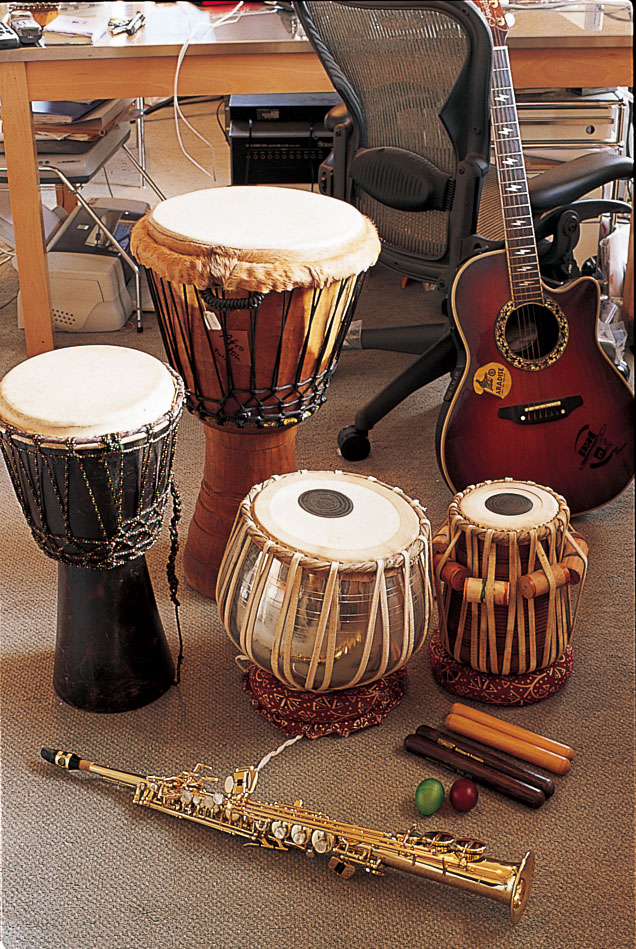
Nujabes, who says he wishes to incorporate live instrumentation into his future track making, has all kinds of instruments in his room. These include a Selmer soprano sax, a Morris electric acoustic, as well as congas, bongos, and other percussion instruments.

※ Nujabes’ used record shop, Tribe. With a relaxed furniture layout and subdued lighting, by the window of the store are also some SL-1200MK3’s embedded inside trial listening tables.
(Note: The address of the store, printed in the original article, has been omitted.)
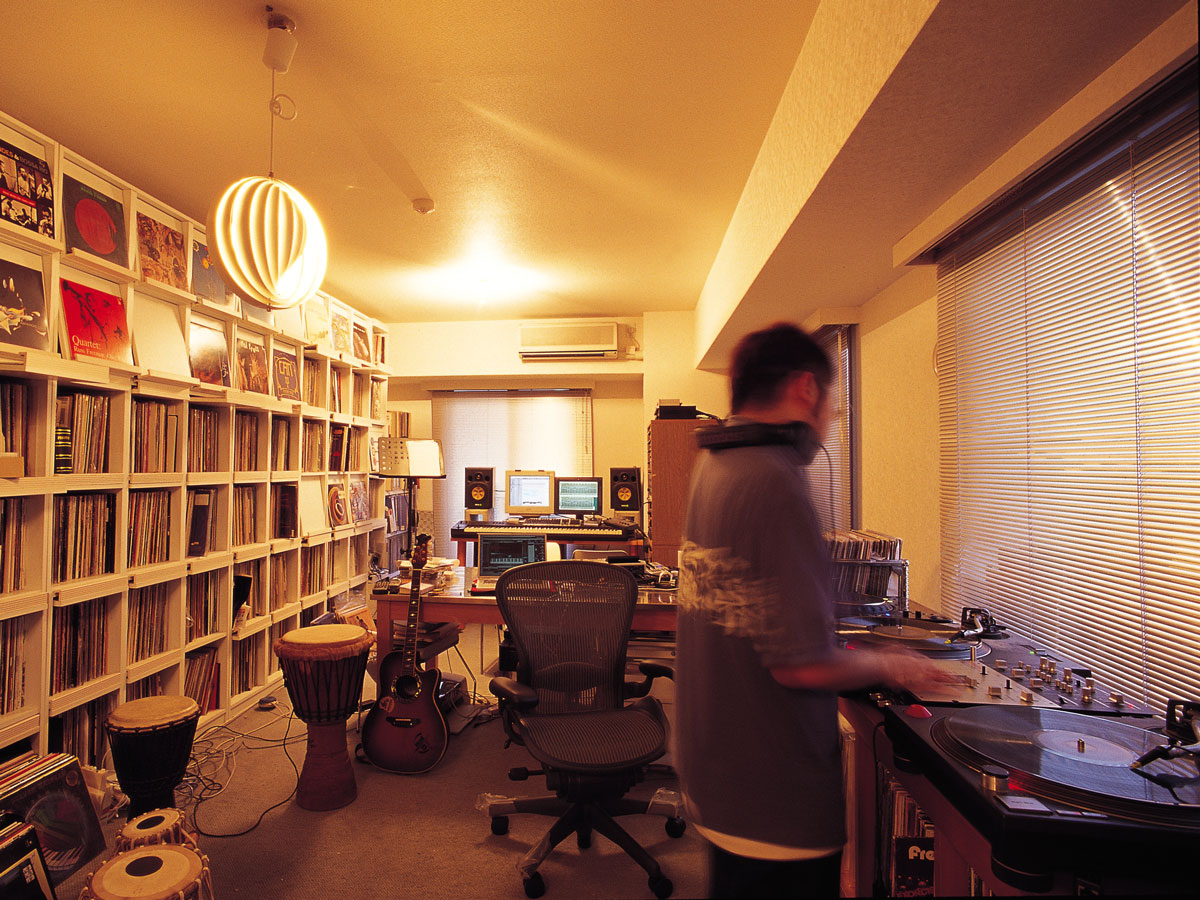

Great read, thank you for translating!
Thanks for reading!
Wonderful stuff. There was a lot of vigor in his explanation of why the album was titled as such.
Hey Dave. Yeah, I liked that bit, too.
This is beautiful, always wanted to read or have a reach on Nujabe’s perspective an thoughts, to imagine his voice and opinion on things, Thank you so much for this interview
Hey Emmanuel. Thanks for reading!
Thanks for translating the interview, he seemed like a guy you could talk with for hours and not get bored! It’s a shame we couldn’t get to know him more…
He sure did. Fascinating character. Thanks for reading!
I respect him so much! I can’t believe he’d fly out his MCs even though it was expensive and difficult. I wish he were still alive.
“If something is worth doing, it’s worth doing well.” –Nujabes, probably.
Wishing he were still alive—you and me both, buddy!
Thank you!
Cheers!
Thank you for taking the time to make this! I love his music and I always wanted to find an interview of him in English. Wish he were still here to make more amazing tracks!
Hey Katie. I know how you feel. I wish there were more Nujabes interviews for me to translate. Cheers!
Nujabes is just such a dedicated person to his craft, the samples cut up by him are as precise as Samurai Champloo, hahah